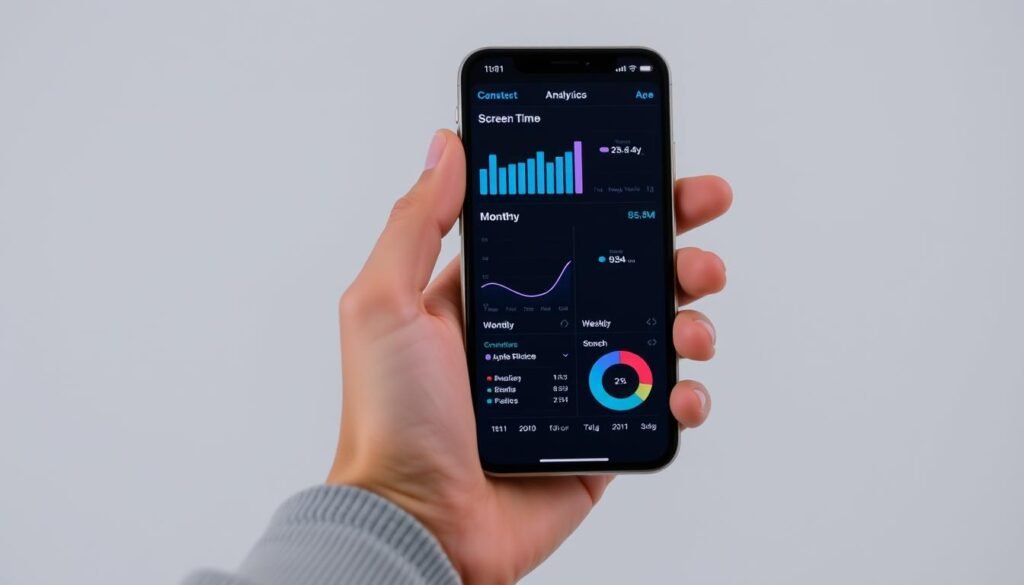Have you ever wondered how much time you spend glued to your screen? Studies show that the average person consumes over 11 hours of media daily. This constant connection can take a toll on your health and well-being.
Instead of completely cutting out technology, we believe in setting achievable boundaries. A digital detox doesn’t mean abandoning your devices forever. It’s about creating healthier habits that stick.
Research from the University of Pennsylvania shows that reducing social media use can lower feelings of loneliness. Sleep studies also reveal that 67% of people use their phone before bed, disrupting their circadian rhythms. By making small changes, you can reclaim your time and improve your mental clarity.
Key Takeaways
- Modern media consumption averages over 11 hours daily.
- A detox focuses on boundary-setting, not complete tech abstinence.
- Reducing screen time can improve mental and physical health.
- Using tools like iOS/Android settings can help create gradual habit changes.
- Small, practical steps lead to lasting improvements in well-being.
Why a 7-Day Digital Detox is Essential for Your Well-Being
Are you aware of the hidden costs of constant screen time? Research shows that excessive use of devices can harm both your physical and mental health. A digital detox isn’t just a trend—it’s a necessity for modern living.
Spending hours on screens can lead to physical issues like poor posture, sedentary behavior, and disrupted sleep due to blue light exposure. Studies reveal that 67% of young adults use their devices before bed, and 42% of pre-sleep texters report poor sleep quality. These habits can increase the risk of obesity by 43% for those who use their devices for five or more hours daily.
Mental health is equally affected. Constant connectivity fuels feelings of FOMO (fear of missing out) and stress, especially among 20-24-year-olds. The Newport Institute highlights how device-mediated interactions strain relationships, creating emotional distance.
But there’s hope. The concept of “digital homeostasis”—balancing tech use with real-life activities—can restore harmony. Limiting social media to 30 minutes daily has been shown to improve well-being significantly. By taking a break, you can reduce anxiety and reclaim your focus.
A short detox isn’t about giving up technology entirely. It’s about creating healthier habits that enhance your life. Start small, and you’ll see big changes in your physical and mental health.
Step 1: Track Your Screen Time and Face the Reality
Do you know how much of your day is spent staring at a screen? The first step to reducing your screen time is understanding where it goes. Most of us underestimate how much we use our devices, but built-in tools can help you see the truth.

How to Use Built-In Screen Time Tools
Both iOS and Android offer features to track your usage. On an iPhone, go to Settings > Screen Time. For Android users, navigate to Settings > Digital Wellbeing. These tools provide a detailed breakdown of your daily habits.
You’ll see how much time you spend on specific apps and categories, like social media or productivity tools. This data can be eye-opening, especially when you compare it to the average 11-hour media consumption baseline.
Interpreting Your Screen Time Data
Once you have the numbers, analyze them. Look for patterns, like “zombie scrolling” during early mornings or late nights. Identify which apps consume the most of your time and whether they add value to your life.
Set benchmarks for improvement. For example, aim to reduce social media usage by 30 minutes each week. Tracking your progress helps you stay accountable and make lasting changes.
Step 2: Set App Limits and Use Screen-Reducing Tools
Ever feel like your apps control your day? It’s time to take charge. Setting boundaries with your phone can help you reclaim your time and focus. Tools like app limits and minimalist launchers make it easier to reduce unnecessary screen usage.
Using App Limits on iOS and Android
Both iOS and Android offer built-in features to manage your apps. On iOS, go to Settings > Screen Time to set daily limits for specific apps. Android users can use Digital Wellbeing to schedule hours when certain apps are off-limits.
These tools help you stay accountable. For example, scheduling social media blackout hours can reduce distractions and improve productivity.
Downloading Minimalist Phone Launchers
Minimalist launchers like Brick or Niagara simplify your phone interface. They remove clutter and prioritize essential functions. Grayscale mode, available on most devices, can also reduce engagement by making your screen less visually stimulating.
Case studies show that reducing notifications can significantly cut down on distractions. For instance, one user reduced 160 Instagram view alerts by adjusting notification controls.
Paid apps like Freedom or Forest offer advanced features for blocking distractions. However, free tools like One Sec can also be effective for managing tech usage. Choose the option that best fits your needs.
Step 3: Take a Social Media Break and Reclaim Your Time
What if you could reclaim hours lost to endless feeds? Social media often feels like a black hole, pulling us in and stealing our focus. A break can help you reset and refocus on what truly matters.

Deleting vs. Temporarily Disabling Apps
When taking a break, you have two options: delete or temporarily disable your apps. Deleting removes them entirely, which can be effective for a clean break. However, temporarily deactivating accounts allows you to return without losing data.
Platforms like Instagram and Facebook offer easy deactivation steps. For example, Instagram lets you pause your account in the settings menu. This flexibility can make it easier to stick to your goals.
Replacing Social Media with Productive Activities
Instead of scrolling, fill your time with meaningful activities. Guided journaling prompts, skill-building apps, or even a creative hobby can be great alternatives. A UPenn study found that limiting social media to 30 minutes daily significantly improves well-being.
Try the “phone stacking” dinner game with friends. Everyone stacks their devices in the center, and the first to grab theirs pays the bill. It’s a fun way to stay present and accountable.
Track your mood before and after your break. Many people report feeling more creative and focused after just 24 hours away from social media. Small changes can lead to big results.
Step 4: Create Tech-Free Zones and Times in Your Daily Routine
How often do you find yourself reaching for your device without thinking? Establishing tech-free zones and times can help you break this cycle. These boundaries allow you to focus on what truly matters, like sleep and meaningful interactions.
No Phones in Bed: The Importance of Sleep Hygiene
Your bed should be a sanctuary for rest, not a workspace or entertainment hub. Studies show that using devices before bed disrupts sleep quality. Blue light from screens suppresses melatonin, making it harder to fall asleep.
Consider creating a charging station outside your bedroom. Affordable options under $25 can help you stick to this habit. Over time, you’ll notice improvements in your sleep, with noticeable changes in as little as three days.
Tech-Free Meals: Enhancing Family and Social Interactions
Mealtime is a perfect opportunity to connect with your family. A tech-free dinner encourages meaningful conversations and strengthens relationships. Try using conversation starter kits to make these moments even more engaging.
Research shows that device-free meals can reduce stress and improve emotional well-being. A multigenerational case study found that grandparents and teens who shared tech-free hours reported feeling closer and more connected.
By setting these boundaries, you’ll create a healthier balance between technology and real-life interactions. Start small, and you’ll see big changes in your daily routine.
Step 5: Incorporate Mindful Rituals to Replace Screen Time
Have you considered how replacing screen time with mindful rituals can transform your day? Small, intentional practices can help you reclaim focus and reduce stress. Let’s explore how to create habits that enhance your health and well-being.
The Benefits of Matcha for Focus and Stress Reduction
Matcha, a powdered green tea, is rich in L-theanine, an amino acid that promotes calmness and mental clarity. Studies show that L-theanine improves cognitive function and reduces anxiety. Preparing matcha can also be a meditative practice, helping you start your day with intention.
Here’s a simple guide to making ceremonial-grade matcha:
- Boil water and let it cool to 175°F.
- Sift 1-2 teaspoons of matcha into a bowl.
- Add 2 ounces of water and whisk until frothy.
- Enjoy mindfully, focusing on the aroma and taste.
This ritual can replace morning scrolling, setting a positive tone for your day.
Creating a Morning Ritual Without Your Phone
Starting your day without screens can boost productivity and mental clarity. Try a 7-day challenge where the first 30 minutes of your morning are device-free. Use this time for stretching, meditation, or journaling.
Invest in an analog or sunrise alarm clock to avoid reaching for your phone first thing. These tools help you wake up naturally and reduce dependency on screens. Over time, you’ll notice improved focus and reduced stress.
By incorporating these rituals, you’ll create a healthier, more balanced routine. Small changes can lead to lasting improvements in your overall well-being.
Step 6: Plan Real-Life Activities to Stay Engaged Offline
Have you thought about how much more fulfilling your life could be offline? Stepping away from screens opens up opportunities to explore the world around you. Planning offline activities can boost your mental health and strengthen your relationships.
Outdoor Activities and Their Mental Health Benefits
Spending time outdoors is a powerful way to recharge. Activities like hiking, biking, or even a simple walk in the park can reduce stress and improve focus. Research shows that outdoor exercise lowers the risk of obesity and enhances overall well-being.
Local activity finder tools can help you discover nearby trails or volunteer opportunities. For example, apps like AllTrails or Meetup connect you with like-minded friends and groups. These tools make it easy to plan your next adventure.
Building Stronger Relationships Through Face-to-Face Interactions
Offline activities also provide a chance to deepen your connections. Shared experiences, like a picnic or a game night, create lasting memories. Studies show that face-to-face interactions strengthen bonds more than digital communication.
Consider creating an “unplugged adventure” packing list to prepare for your outings. Bringing a digital camera instead of relying on your smartphone can also help you stay present. These small changes can make a big difference in your life.
After your detox, assess how these offline moments have impacted your social connections. You might find that spending quality time with loved ones has brought you closer than ever before.
Conclusion: Embrace the Benefits of a 7-Day Digital Detox
Taking a step back from constant connectivity can transform your daily experience. A digital detox isn’t just about cutting screen time—it’s about reclaiming your life and improving your health. By setting boundaries, you create space for meaningful moments and lasting habits.
To make these changes stick, consider a 30-day habit formation roadmap. Tools like the Newport Institute’s mental health assessment can help you track progress. Pair this with mindful rituals, such as a matcha subscription, to maintain focus and reduce stress.
Relapse is natural, but prevention strategies like community challenges can keep you on track. Join others in tracking progress and celebrating small wins. Together, we can find a better way to balance technology and time for what truly matters.
FAQ
Why is reducing screen time important for mental health?
Reducing screen time helps lower stress, improve sleep, and increase focus. It also allows more time for meaningful activities and face-to-face interactions, boosting overall well-being.
How can I track my daily usage effectively?
Use built-in tools like Screen Time on iOS or Digital Wellbeing on Android. These apps provide insights into how much time you spend on different apps and websites.
What are some practical ways to limit app usage?
Set daily app limits using your device’s settings or download minimalist launchers like Siempo or Before Launcher to simplify your home screen and reduce distractions.
Should I delete social media apps or just disable them?
Temporarily disabling apps is a great first step. If you find it helpful, consider deleting them entirely to create a longer break and focus on offline activities.
How can I create tech-free zones at home?
Designate areas like the dining table or bedroom as tech-free zones. This encourages better sleep hygiene and more meaningful interactions with family and friends.
What are some mindful rituals to replace scrolling?
Start your day with a phone-free morning ritual, like meditation, journaling, or enjoying a cup of matcha. These activities promote focus and reduce stress.
How can I stay engaged offline during the detox?
Plan outdoor activities like hiking or biking, or spend time with loved ones. These activities improve mental health and strengthen relationships.
What if I feel anxious about missing out on updates?
Focus on the benefits of being present in the moment. Remind yourself that most updates can wait, and prioritize your mental health over FOMO (fear of missing out).




